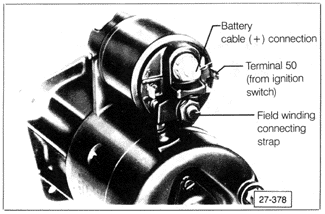6.2 Removing and Installing Starter
To remove the starter, first disconnect the ground strap from the negative (-) battery terminal. On cars with automatic transmission, work beneath the car to remove the two bolts that hold the cover plate to the starter, and remove the plate. Disconnect the wire to terminal 50 and the positive (+) battery cable from the starter solenoid. Note the location of any other wires attached to the starter and then disconnect them. Remove the bolts that hold the starter to the transaxle bellhousing and remove the starter. On cars with automatic transmission, it is also necessary to remove the bolt holding the starter mounting bracket to the engine. Inspect the starter. Replace or repair the starter if the drive pinion teeth are worn or broken. On cars with manual transmission, inspect the starter bushing that is pressed into the transaxle's bellhousing. If the bushing is worn or damaged, it should be replaced as described below. Installation is the reverse of removal. Lubricate the starter bushing with multipurpose grease. On cars with manual transmission, torque the starter mounting bolts to 60 Nm (43 ft. lb.). On cars with automatic transmission, torque the mounting flange bolts to 20 Nm (15 ft. lb.), and torque the starter mounting bracket mounting bolt to 25 Nm (18 ft. lb.). Install the starter wire as shown in Fig. 6-1.

|